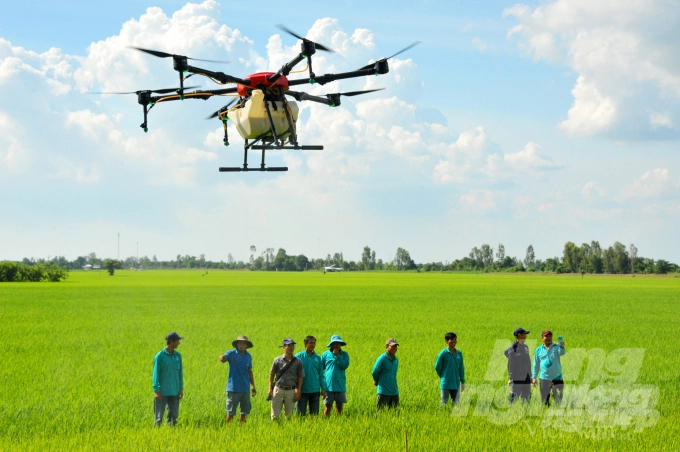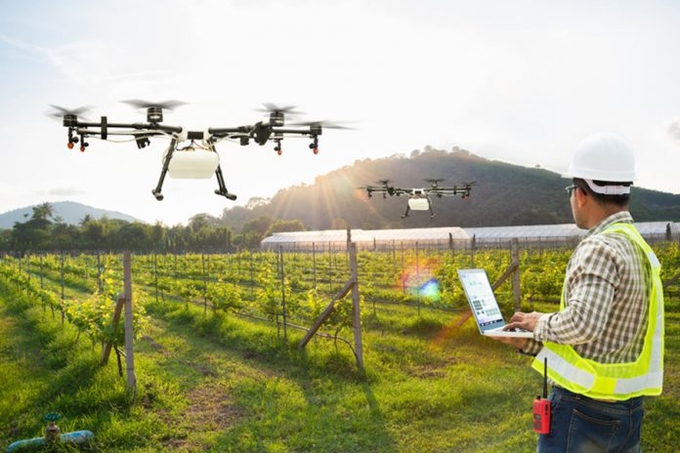On January 17, the Ministry of Plant Protection announced the basic standards for field trials of pesticides to prevent and control crop pests by using unmanned aerial vehicles (UAV/drones).

Organizations and individuals that supply and operate UAVs are authorized to use flying devices according to the regulations; trained in the safe use of pesticides. Photo: tsp.
Only use the UAV within the permitted range
This basic standard specifies the principles, content and methods for evaluating the biological effectiveness, determining the isolation time of pesticides that are sprayed and spread with UAV devices in the field, and basic requirements for the safe operation of UAV devices.
The standard applies to UAV devices used for the purpose of preventing and controlling crop pests, regulating plant or insect growth, and increasing the safety and effectiveness of pesticide use in agriculture.
The standard clearly states on the safety requirements when using unmanned aerial vehicles for spraying pesticides in the field: Organizations and persons that supply and operate unmanned aerial vehicles are authorized to use aircraft according to the regulations; trained in the safe use of pesticides. The place and time of use of the UAV must be approved by the regulatory authority and comply with the applicable regulations for the use of unmanned aerial vehicles.
Equip labor protection equipment and medical first aid kits for UAV operators according to regulations to ensure safety when handling medicines.
In addition, the UAV equipment must ensure safety during use and comply with technical standards. When using pesticides by UAV, be careful not to spread the pesticides to other areas to ensure the safety of people, pets and the environment during pesticide use. Packets of pesticides are properly collected after use.
Regarding the requirements for harmful organisms and plants, test conditions: The test is carried out at a time that is favorable for the growth and development of the harmful organisms to be tested and on representative cultures of the region.
Growing conditions (soil, fertilizers, plant varieties, density) must be consistent throughout the trial area and in accordance with local agricultural practices. No pesticides were used on the test area (including formulations and separators) during the trial period.
In cases where the use of drugs to eliminate other harmful organisms is imperative, the drugs used must not adversely affect the drugs to be tested or the target organisms and must be sprayed evenly over all plots listed). When handling the drug, do not allow the drug in one test plot to be transferred to another test plot.
For PHI testing: At least 20 days before performing the test, the testing site must ensure that they are not handling any drugs with the same active ingredients or active ingredients that may interfere with the residues of the drugs being tested.
Regarding the requirements for UAVs, UAV equipment used for spraying and spraying pesticides must have technical characteristics (parameters) and clear operating instructions from the manufacturer, and be approved for use. is an aircraft for spraying pesticides.
The device of the sprayer (nozzle) of the UAV is suitable for the type of pesticide, the growth stage of the plant and the harmful organism to be tested.
The basic specifications of the UAVs used in the same drug test should be similar in terms of the number of nozzles, particle size and injection pressure.
Regarding the requirements for testing equipment and instruments, UAV testing of pesticides requires the following minimum equipment and tools, in addition to the means and equipment for testing pesticides according to the regulations:
anemometer, temperature meter, humidity meter, navigator, stopwatch; instruments for weighing, measuring, measuring and mixing pesticides; sample containers, preservative ice (for PHI testing); Equipment and instruments used in the organization of tests and investigations of harmful organisms to be tested.

UAV equipment used for the purpose of spraying and spraying pesticide is equipment that must have clear specifications and operating instructions from the manufacturer and has been approved for use as a pesticide spraying aerial vehicle. Photo: Trung Quan.
Other tips for handling pesticides with UAV: Handle the drug when the wind speed is not more than 6 m/s (the optimal speed is about 3 m/s). Do not touch the medicine when it is going to rain; wind direction is constantly changing; the humidity is less than 50%; the air temperature is higher than 35°C.
The height between the drone and the plant must be consistent and follow the manufacturer’s recommendations. The amount of drug water used and the width of the UAV trajectory should be calibrated and determined before starting drug treatment. Do not change the width of the trajectory arbitrarily, resulting in spray or overspray during handling.
In particular, use the UAV only to the extent licensed. The area where the UAV is handled must be posted with warning signs and safety instructions.
Know the area of the test plot and the number of repetitions
The baseline standard also indicates the area of the test plot and the number of replicates. Accordingly, the following applies to the biological effectiveness test: When conducting a close field test, the test area must be at least 150 m2 for the group of food plants, vegetables, flowers, ornamental plants, medicinal plants and industrial plants, briefly tea, fruit trees in the form of creepers and cows.
The test area must include at least 15 trees (poison, pillar, pot) for fruit trees, forest trees, long-term industrial plants and large shrubs (planting density is less than 1,000 trees/ha).
The minimum number of repetitions is 3 times. The test plots are arranged to meet the technical requirements of the field test design and ensure at least 3 flight paths of the UAV equipment.
When conducting large-scale experiments: the area of the experimental area must be at least 300 m2 for groups of food plants, vegetables, flowers, medicinal plants, short-term industrial plants, tea trees, climbing fruit trees and cow body fruit trees
In the case of groups of fruit trees, forest trees, permanent industrial plants and large trees (planting density less than 1,000 trees/ha), the test area must include at least 30 trees (poison, poles, pearls).
The large-scale experiment was not repeated. The test plots are arranged sequentially or randomly, ensuring at least 5 trajectories of the UAV.
There must be a minimum of 3m wide partition between experimental treatments or 1 row of trees (with a large magic tree) or shielding measures to prevent the drug from splattering from one formula to another when spraying consciousness.
For testing to determine PHI: Large-scale, non-repetitive testing, the area of each test plot must ensure that sufficient total sample is collected at each sampling point. The minimum area of the test area is 30 trees for perennial fruit trees. Minimum area of test area 300 m2 for vegetables, tea, fruit trees in the form of creepers and cows.

The standard stipulates that UAVs may only be used within the scope of their approval. The area where the UAV is handled must be posted with warning signs and safety instructions. Photo: tsp.
The test plots are arranged sequentially or randomly, ensuring at least 5 trajectories of the UAV. There must be a minimum dividing line of 3 m between the test plots for vegetables, tea trees, climbing and deciduous fruit trees or 1 row of trees for perennial fruit trees…
In addition, the standard also specifies the content related to the test formula; conduct drug treatment; monitoring criteria of the drug tested; timing and number of sample surveys; Calculation of drug efficacy results, the basis for determining PHI; processing of data from biological efficacy tests; assess the effect of drugs on plants; observation and recording of weather; Review…

